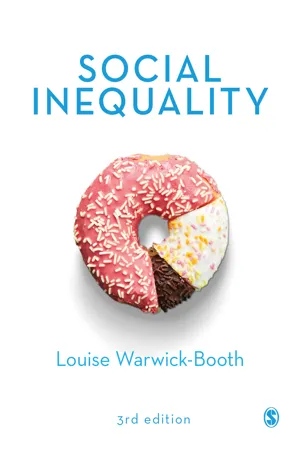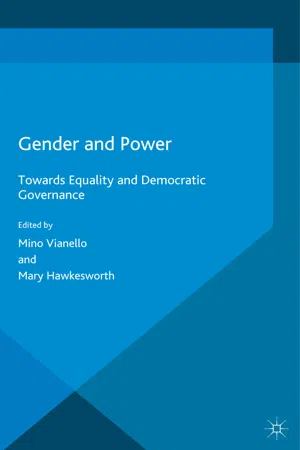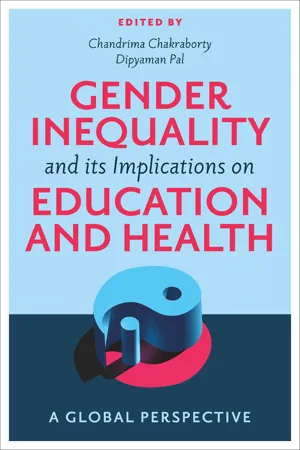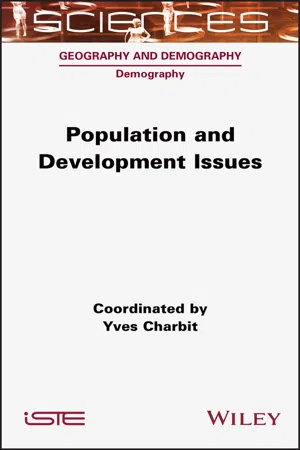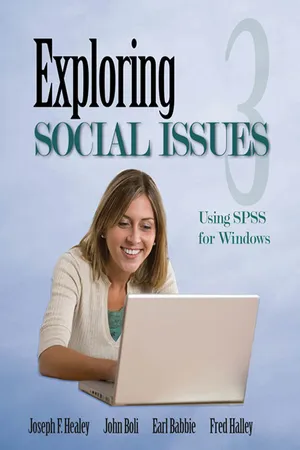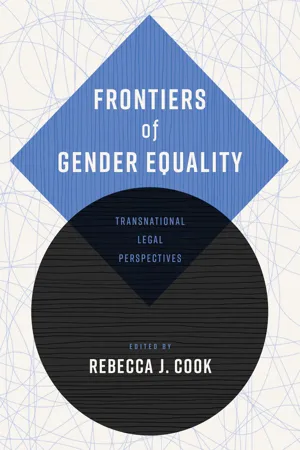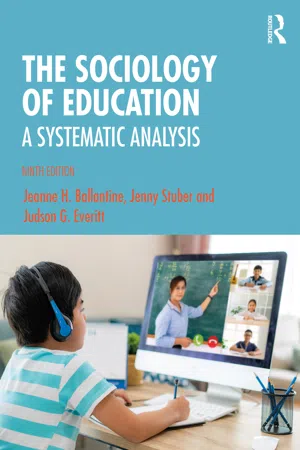Social Sciences
Gender Inequality
Gender inequality refers to the unequal treatment or perceptions of individuals based on their gender. This can manifest in various forms, such as unequal access to opportunities, resources, and rights. It is a pervasive issue that impacts individuals and societies, and efforts to address gender inequality often focus on promoting gender equity and challenging discriminatory attitudes and practices.
Written by Perlego with AI-assistance
Related key terms
11 Key excerpts on "Gender Inequality"
- eBook - ePub
- Mary Evans(Author)
- 2016(Publication Date)
- Polity(Publisher)
1What is Gender Inequality?Debates about gender have existed in both print and daily life for generations, and heated discussions about the state of relations between men and women show little sign of decreasing. In the early decades of the twenty-first century, issues about gender and sexual identity have become the subjects of increasingly complex debates, whilst the actual lived experience of gender can still be defined by rigid and often non-negotiable assumptions derived from biological difference. For example, debates arising out of the politics of transgender have called into question the very meaning of the terms ‘male’ and ‘female,’ whilst in certain parts of the world these very definitions of identity constitute mandatory forms of social existence. Discussions about gender exist universally; it is the nature of the debate, and certainly the degree to which it is a matter of public debate, that differ. But apart from these debates – about the implications of biological difference – there is a considerable degree of consensus that women, both born and made, have less access to power and privilege than men. Hence, although we speak of ‘Gender Inequality’, the term here has a more specific focus. It refers to those various social inequalities which are more often experienced by women than men. Those inequalities take forms which will be the basis of the discussion here and in later chapters: those of material and political disadvantage and of various forms of abusive representation.At that point, and through the use of the apparently inclusive term ‘women’, we encounter a potential minefield: a minefield in which much of the strength of that binary division between women and men is disrupted. Questions of class, of race, of sexual identity, of age, of ethnicity all disrupt any simplistic view that gender ‘inequality’ is solely a question of all men having more power and privilege than all women. There are two reasons for this: one is the point that the American academic Kimberlé Cranshaw made in 1991 when she wrote about the ‘multiple grounds of identity’ – of gender, race and class - which we all occupy. In doing so she articulated the concept of ‘intersectionality’, the recognition that all human beings are located within conditions of class and race as well as that of gender.1 - eBook - ePub
- Louise Warwick-Booth(Author)
- 2022(Publication Date)
- SAGE Publications Ltd(Publisher)
6 Social Divisions and Inequality: GenderKey learning outcomes
By the end of this chapter, you should be able to:- understand the ways in which gender is defined;
- understand the relationship between social inequality, gender and intersectionality;
- understand the different ideological positions associated with explaining the existence of gender-related inequalities.
Overview of the chapter
This chapter provides an overview of gender as a contemporary social division, defining it and exploring its relationship with social inequality. It explores how gender is related to social status and therefore illustrates how social characteristics relate to experiences of inequality in very different ways. It compares the progress made in terms of increased gender equality and setbacks. Evidence shows that gender inequalities still permeate much of the world, linked to social inequality as well as status and power in complex ways for both men and women. This chapter looks at the complex relationship between gender and social inequality and outlines the importance of the global context in relation to gender inequalities. Finally, it examines explanations offered in the literature that tell us about why gender inequalities remain a problem within contemporary societies across the world.What is gender?
Gender is simply the social, behavioural and cultural attributes that are associated with being a man or a woman.Defining gender- Thompson and Armato (2011) argue that gender is created and maintained through complex societal arrangements and practices; thus gender is socially constructed.
- Gender is the system of beliefs and practices that refer to and create a sense of difference between men and women (Connell 1987).
- The WHO (2017b) defines gender as ‘the socially constructed characteristics of women and men – such as norms, roles and relationships of and between groups of women and men. It varies from society to society and can be changed’.
- eBook - ePub
Gender and Power
Towards Equality and Democratic Governance
- Mino Vianello, Mary Hawkesworth, Mino Vianello, Mary Hawkesworth, Mino Vianello, Mary Hawkesworth(Authors)
- 2016(Publication Date)
- Palgrave Macmillan(Publisher)
Part II Explaining Inequalities: Multidisciplinary Perspectives Section Introduction Luigi ZojaFor many, the nature of gender remains self-evident: the human species encompasses men and women. Biological diversity is subsequently culturally channeled, thereby creating a plethora of differences, which are manifested in social roles, divisions of labor, status hierarchies, structures of consciousness, stylizations of bodies, as well as individual desires and aspirations. Within the interdisciplinary field of gender studies, scholars have introduced a number of important distinctions to illuminate the complexity of gender as an amalgam of sex, sexuality, sexual identity, gender identity, gender role, gender role identity, social relations, cultural norms, and institutional arrangements. Yet, once the manifold dimensions of gender are enumerated, additional questions arise: What do these phenomena have to do with one another? How are they interrelated? And why is gender difference so routinely channeled into systems of advantage and disadvantage that privilege men?The chapters in this section are rooted in the puzzle of pervasive and persistent gender inequalities. Rather than naturalizing these unequal relationships, these chapters attempt to explain why gendered differences in opportunities, roles, power, and rights that disadvantage women surface in virtually all societies. To explore this question, the chapters draw upon diverse intellectual disciplines – anthropology, economics, history, neuroscience, philosophy, psychoanalysis, and sociology. Informed by different theoretical paradigms and multiple methodological approaches, the chapters offer a wide range of insights into cultural, historical, social, psychological, and political structures of power.Despite their widely varying analyses, the chapters have some common ground. The authors agree that any adequate understanding of Gender Inequality must supplement biological claims with detailed attention to cultural conventions, economic contributions, species survival, social hierarchies, and political agendas. They concur that gender identity and the concrete behaviors by which it manifests remain at great remove from nature, having been structured to promote mainly (or exclusively) the advantage of males. Whether legitimated through appeals to men’s “natural” superiority, divine will, economic efficiency, or sexual complementarity, men have claimed an entitlement to public institutions and indeed, the public sphere, attributing to these domains rationality, factuality, reliability. Men have credited themselves with greater physical strength and greater capacity to provide subsistence, despite shorter lifespans, and empirical evidence that women were the mainstay of subsistence agriculture prior to the 19th century in the West, and remain so across the global South to this day. Men have transformed a relative advantage stemming from not being responsible for breastfeeding, which accorded them a marked difference in freedom in pre-modern societies in which one pregnancy followed another, into a system of male domination. The imbalance of gendered power grew exponentially when men attributed to themselves not only the monopoly of legitimate violence (control of military and police forces) but also of political and economic life. In principle, neither the rule of law nor the management of the economy is linked to gender. In practice, however, men have used custom, law, religion, and tradition to bar women from equal participation in these spheres. Paradoxically, an imbalance of power grounded in the exercise of brute force increased exponentially through cultural transformations, which have been celebrated as civilizational achievements: these include the enlightenment, secularization, and the overthrow of feudal systems that tied privilege to particular families. - eBook - ePub
- Nan de Graaf, Dingeman Wiertz(Authors)
- 2019(Publication Date)
- Routledge(Publisher)
8 Gender inequalitiesChapter overviewMany areas of society are characterized by Gender Inequality, in some cases partly driven by discrimination against women. This applies to practically every country across the globe and it implies, among other things, that a large stock of human capital is left under-utilized. We start this chapter with a historical sketch of Gender Inequality and go on to describe and explain the process of gender emancipation, highlighting the three waves of emancipation that took place during the twentieth century. Next, we examine international variation in Gender Inequality, followed by a discussion of gender discrimination and its role in explaining gender pay gaps. We subsequently address several major trends in female labour force participation and women’s educational attainment. Finally, we shift our attention to the influence of women’s rising labour market participation and educational attainment on gender-related issues within the private sphere, namely marriage patterns, fertility decisions, and domestic divisions of labour. Our overall conclusion is that, while Gender Inequality has certainly diminished in many life domains, the gender revolution is still far from being finished.Discrimination and Gender Inequality as a problemDiscrimination on the basis of age, gender, sexual preference, race, skin colour or ethnic background is widely denounced in most societies. This sentiment is also reflected in Article 2 of the United Nations’ Universal Declaration of Human Rights, which states, “Everyone is entitled to all the rights and freedoms set forth in this declaration, without distinction of any kind, such as race, colour, sex, language, religion, political or other opinion, national or social origin, property, birth or other status”. In 1979, the United Nations General Assembly additionally adopted a convention seeking to eliminate all forms of discrimination against women. This underlines that the absence of discrimination is generally regarded as a public good, even though there are also still states that impose rules prohibiting women from entering certain occupations or from engaging in certain activities, such as driving or being out by themselves. For example, in Saudi Arabia the ban on women driving was only lifted in 2017. - eBook - ePub
Gender Inequality and its Implications on Education and Health
A Global Perspective
- Chandrima Chakraborty, Dipyaman Pal, Chandrima Chakraborty, Dipyaman Pal, Chandrima Chakraborty, Dipyaman Pal(Authors)
- 2023(Publication Date)
- Emerald Publishing Limited(Publisher)
Gender Inequality is one of the most concerning issues for a developing country like India. Gender Inequality has many dimensions which are intricately related to the socioeconomic structure of the country. The chapter highlights two dominant factors leading to Gender Inequality in the country – education and employment. Empirical evidence suggests that the gross enrollment of females decreases from the upper primary level of schooling onwards. Moreover, higher education for women has not translated to higher employment post liberalization. India continues to be a country with one of the poorest female work participation ratios. Employment along with education is a key tool to improve the condition of women in our society. The chapter concludes that an integrated approach linking education of women and employment is essential for the reduction of Gender Inequality.Keywords: Gender Inequality; education; gross enrollment ratio; socioeconomic structure; work participation ratio; India1. Introduction
The term “Gender Inequality” refers to discrimination between men and women. Gender Inequality is universal and a common phenomenon to all countries across the globe. Evidence shows that throughout the world, women receive lower wages than men. Gender Inequality is most reflected in the spheres of education and employment. This adversely affects the quality of life of women and the economic growth of the country (Moheyuddin, 2005 ). Needless to say that the magnitude of Gender Inequality is far greater in developing countries like India than the developed countries. The United Nations has announced the Sustainable Development Goals to be achieved by 2030, which separately includes the Agenda of Gender Equality. It has given special importance to establish equality for women among all sections and age groups worldwide, by eliminating the effect of poverty, food insecurity, and other economic adversities (World Bank Report, 2000 - eBook - ePub
Gender Equality from a Modern Perspective
Moving Beyond Diversity
- Tanusree Chakraborty, Nandita Mishra, Ashok Natarajan, Bipasha Chatterjee, Tanusree Chakraborty, Nandita Mishra, Ashok Natarajan, Bipasha Chatterjee(Authors)
- 2023(Publication Date)
- Apple Academic Press(Publisher)
Chapter 14 Gender Equality and Inequality: Exploring the Dynamics of Gender BiasSOUMITA MITRA1 and SARITA KAR21 Research Scholar, IIT (ISM), Dhanbad, Jharkhand, India2 Assistant Professor, Department of Humanities and Social Science, IIT (ISM), Dhanbad, Jharkhand, India________________________________ Gender Equality from a Modern Perspective: Moving Beyond Diversity. Tanusree Chakraborty, Nandita Mishra, Ashok Natarajan, Bipasha Chatterjee (Eds.) © 2024 Apple Academic Press, Inc. Co-published with CRC Press (Taylor & Francis)ABSTRACT
Today, we can call ourselves modern in terms of what psychological changes and social improvements we have achieved for ourselves. The human race has traveled a long distance in trying to make themselves more civilized and develop his natural “humane” qualities lying latent within them. Such overall modifications were implied in order to allow a holistic change of the world. But to the utter dismay, it is still seen that there is a state of “Cold War” going on in terms of gender discrimination. Even though women have already proved their expertise in all sectors of life, she is often denied the respect and appreciation she deserves to receive most often. Her position is till now assumed to be permanent within the threshold of the house.Therefore, this work of mine would actively engage in finding out the areas, where the women are being deprived of their basic rights. It would also work towards finding out what milestones have been achieved by her and what is yet to do done, in order to build a harmonious society.14.1 Introduction
The practice of discriminating against individuals on the basis of their gender has been a common scenario all throughout the world. Rights also got similarly divided between them, based on the superiority of their genders. Gender roles or gender norms became automatically attached to them. One’s ability to cope up with various social pressures, also depends invariably on the gender. Studies have expressed that an individual’s ability to absorb the shocks is based on how the social and cultural entities of the society have taught them to behave in a particular situation or rather has restricted their actions to the fixed periphery. As, it has been found that a lady who is mostly dependent on her husband to fulfill her needs for sustenance and who basically carries out the role of being a homemaker may undergo more mental anguish in case of facing separation, than one who is self-supportive. Therefore, elasticity in one’s conduct can help them become adaptive and adjust their life in a simplified manner (Patterson and McCubbin, 1984 - eBook - ePub
- Yves Charbit(Author)
- 2022(Publication Date)
- Wiley-ISTE(Publisher)
4 Gender Inequalities Serge RABIERFrench Development Agency, Paris, France4.1. Current theories and debates
The emergence of the analysis of gender relations in the social sciences since the 1980s and 1990s has become evident in disciplines such as sociology, anthropology, political science and economy. These have called into question the classic concept of homo economicus through the generalization of gender statistics. Demographics have not stayed away from this movement. A gender-sensitive approach to migrations has thus made it possible to determine the ways in which unequal relations between women and men have structured and affected migration phenomena. Another example is the preference for boys (and the elimination of girls before or after birth), something which strongly impacts not only the demographic pyramids of countries such as India and China, but also those of neighboring countries via the trafficking and forced migration of “missing girls/women”, mentioned in Chapter 6 . When gender questions are integrated into the various fields of demography (migrations, nuptiality, fertility, family structures, gender-biased roles in the sphere of care and mortality), they appear as tools for bringing to light (individual or collective) subjects and social practices previously underestimated, devalued and invisible in the purely quantitative dominant approaches.Gender relations in the health and education sectors are among the most unequal and constitute essential dimensions of demographic changes, both for achieving individual aspirations and in terms of public policy strategies, specifically in population matters. The integration of individual conditions and aspirations (legal, political, economic and social “capabilities”) into development processes is the focus of the reflections of Amartya Sen, the 1998 Economics Nobel Laureate (Sen 1987). By defending population policies through development, Sen revives the moral and practical dimension of people’s right to realize their aspirations for freedom from a gender perspective. - eBook - ePub
Exploring Social Issues
Using SPSS for Windows
- Joseph F. Healey, John E. Boli, Earl R. Babbie, Frederick S. Halley(Authors)
- 2009(Publication Date)
- SAGE Publications, Inc(Publisher)
t -tests showed that there were only minor differences between men and women in terms of educational achievement (EDUC) and occupational prestige (PRESTG80). However, a statistically significant degree of Gender Inequality was evident on income (INCOME06). How can we account for this pattern? Specifically, if men and women are roughly equal in their qualifications for the job market (average years of education), shouldn’t they also be equal in income? Has the movement toward gender equality been only partially successful? It seems that women have achieved near parity in some areas of social life (education) but not in others (income) and that society has some distance to go before gender equality is fully realized.It would require a great deal of analysis to fully explain these patterns and address the underlying issues. In this limited space, all we can do is suggest some of the reasons for the gender gap in income. For one thing, various researchers have documented continuing sexism in the job market (e.g., see Greenman &Xie, 2008). Women are less likely to be considered for the top jobs with the highest income levels. Another factor reflects sexism more indirectly. Women, even those with full-time, professional credentials, are expected to attend to housekeeping and child-rearing duties. To balance these responsibilities, women are more likely to work part-time rather than full-time and are less likely to make a total commitment to their careers. Also, women who work outside the home tend to be concentrated in such relatively low-paid occupations as nurse (vs. physician), elementary schoolteacher (vs. college professor), secretary (vs. business executive), retail clerk, and waitress. - eBook - ePub
Frontiers of Gender Equality
Transnational Legal Perspectives
- Rebecca J. Cook, Rebecca J. Cook(Authors)
- 2023(Publication Date)
- University of Pennsylvania Press(Publisher)
Part IUnderstanding Gender Inequality and Equality
Passage contains an image
Chapter 1
Faces of Gender Inequality
Sophia Moreau1. A Pluralist Approach to Gender-Based Discrimination
Inequalities based on gender are morally troubling for a number of different reasons. Consider violence against women. It is morally concerning at least partly because it places many women’s lives and health in danger. We can acknowledge this as a harm without making any comparison between women and men. But violence against women is concerning also because of the ways in which it results from, and also perpetuates, the disempowerment and silencing of women, a disempowerment and silencing that many men do not experience. So violence against women is also a problem of discrimination. And it is made possible by the persistence of gender stereotypes that work, either tacitly or explicitly, to rationalize the power relations that render women vulnerable while leaving men in a position where they can often dominate with impunity.Interestingly, even the discriminatory aspect of violence against women seems to have multiple component parts, which cannot easily be reduced to a single harm. Such violence subordinates women to men—that is, it is caused by, and in turn perpetuates, a social order in which women systematically have less power and authority than men and attract less deference than men, and in which women’s needs are often marginalized or rendered invisible. Violence against women also denies many women the freedom to shape their lives in a manner of their own choosing. And when it occurs within the family, it leaves women without access to a good that is a necessary condition for functioning as an equal in their society: namely, a home that is a place of respite, a place where one can gather one’s strength, a place where one is secure and respected. It is not obvious that these different harms—social subordination, a lack of certain important freedoms, and a denial of access to a basic good—are reducible to some single type of harm or single type of disvalue. I have argued elsewhere that they form different parts of a pluralist theory of what makes discrimination wrong.1 - eBook - ePub
Angles Of Vision
How To Understand Social Problems
- Leonard Beeghley(Author)
- 2018(Publication Date)
- Routledge(Publisher)
3 Gender InequalityOutline of Chapter 3
I. Dimensions of Gender Inequality A. Historical Dimensions B. International Dimensions II. Consequences of Gender Inequality A. Male Authority B. Female Victimization III. Individuals and Gender Inequality A. Women’s Choices B. Discrimination IV. Social Structure and Gender Inequality A. The Preservation of Gender Inequality 1. The Salience of Traditional Gender Norms 2. Institutionalized Discrimination B. The Decline of Gender Inequality 1. Industrialization 2. Female Labor Force Participation 3. Advances in Medical Technology 4. Legal Changes 5. The Rise of Feminism V. Implications When I was born, just after World War II, most people wanted a house in the suburbs. From there, Mom was supposed to watch the kids and Dad leave for work. He was supposed to compete with other men to produce goods and services, make public policy, interpret God's will, and cure the sick. It was a "Father Knows Best" world. Indeed, in the television series of that name, Jim Anderson left each day in the family car to sell insurance, while Margaret remained at home, isolated and dependent. She had no job and probably not even a driver's license. Her tasks were to watch the children, clean house, order deliveries of groceries, prepare dinner, and do anything Jim needed. In fact, his company assumed that she provided support services. On arrival home, the children presented their father with minor problems, which he resolved prior to the end of each show. The point, of course, was that "father knows best"; in retrospect it seems like a (very) bad after-school special. But this show suggests how people thought married life ought to be: One sex was supposed to serve as domestic servants for the other. Or to put it more charitably, married women's family duties were supposed to be the center of their lives. In contrast, men's economic abilities were supposed to be the center of their lives.1 - eBook - ePub
The Sociology of Education
A Systematic Analysis
- Jeanne Ballantine, Jenny Stuber, Judson Everitt(Authors)
- 2021(Publication Date)
- Routledge(Publisher)
Documented differences exist in the educational achievement in boys and girls. While boys outscore girls on tests of mathematical ability and science knowledge, girls outperform boys on tests of reading and writing. At the end of their high school years, boys have higher scores on the SAT and many AP exams, but girls have the edge in GPAs. It is unlikely that these differences reflect underlying biological factors or innate differences; instead, they are likely the product of socialization and the social organization of schooling. Gender differences also exist in social experiences, with boys being subject to the “guy code,” and girls still facing expectations to be thin and popular, but also smart and successful.III. Gender Differences in Higher Education (and Graduate School)
Since 1982, females have represented a majority of college students. More recently, they have come to represent about half of those pursuing graduate degrees. These patterns of educational attainment reflect an emerging form of Gender Inequality: the possibility that boys and men are falling behind, and that the educational system has not adapted to meet their educational and social needs. Others worry that gender socialization has not adapted to broader economic changes, including the decline of manufacturing work and men’s wages, and that it may take some time for boys and men to adapt to the growth in traditionally female job sectors, like education and healthcare. Still, while females are more likely than men to achieve advanced degrees, they still earn less than men, and continue to face subtle and not-so-subtle forms of sexism in higher education.IV. Efforts to Combat Gender Inequalities in Education
Given the complicated patterns of gender differences and inequalities in schools, myriad efforts exist to rectify these patterns. One solution may be single-sex education. Single-sex education may encourage girls to develop deeper interests and confidence in the STEM fields, and allow teachers to adapt their pedagogy to meet boys’ learning styles. Critics, however, suggest that single-sex education does not produce documented educational benefits, and worry that separate educational facilities reinforce rather than reduce gender differences in education. Within higher education, Title IX has received a new identity. While it once focused almost exclusively on athletic equity, it is currently being used as a tool for protecting students’ rights to be educated by making sure that colleges and universities have adequate policies and procedures to deal with sexual assault.
Index pages curate the most relevant extracts from our library of academic textbooks. They’ve been created using an in-house natural language model (NLM), each adding context and meaning to key research topics.

